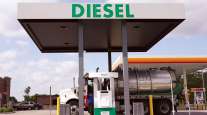Future of Combustion Engines Promises Efficiency, Green Fuels

[Stay on top of transportation news: Get TTNews in your inbox.]
Advanced researchers and engine makers say the internal combustion engine’s ability to be more efficient and run on greener fuels means an extended life.
Upcoming changes range from detailed improvements to mechanical design or better emission systems that free the engine to run more efficiently, to radical architectural and combustion system changes. These will allow the use of very different, greener fuels that are at least 85% lower in CO2 emissions.
With the introduction of its 2024 VNL, Volvo made some unusual changes to its D13 engine’s internal architecture described by Duane Tegels, product marketing manager for powertrain at Volvo Trucks North America. By shortening the piston’s structure, Volvo was able to make the connecting rod longer. This matters because the angle of the rod from vertical at the midpoint of the power stroke is then closer to vertical. This means a reduction of 6% in side thrust, which means less engine friction.
The new piston also features seven waves for sprays of fuel rather than six, allowing a seven-hole fuel injector. Tegels says that the resulting “advancements in combustion efficiency yield significant improvements in the fuel-to-air mixture, consequently reducing soot emissions. This enhancement is not solely attributed to piston design but rather emerges from the synergistic collaboration of the injector, piston and turbocharger components.” This results in reduced heat stress on the piston, and enhanced lubrication because of reduced breakdown of the oil from heat. That in turn means extended component life, he said.
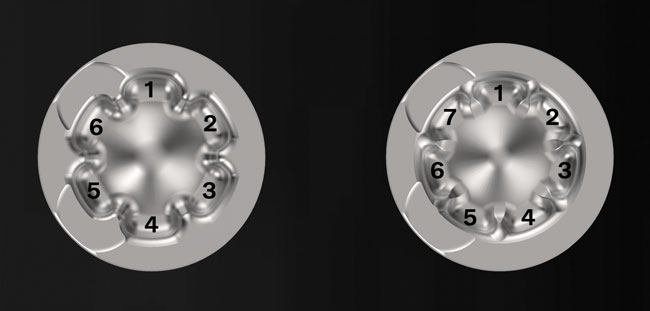
The D13 engine in the 2024 VNL has a piston with seven waves rather than six, meaning slightly smaller sprays from the fuel injector, and more complete combustion. (Volvo Trucks)
2027 rules require meeting lower NOx standards while using less fuel. This could be problematic because NOx forms at the high cylinder temperatures required for diesel efficiency. But selective catalytic reduction technology can take care of NOx, leaving engineers free to build high-efficiency diesels with higher peak cylinder pressures and temperatures. The superior aftertreatment system Cummins Inc. will use with its 2027 HELM version of the X15 takes advantage of this principle.
SCR made NOx control simple until deteriorating road speeds, especially in populous states like California, killed its effectiveness because of the need to operate in crawling traffic. Diesels cool in these conditions, and this stops the catalytic reaction that kills NOx. The 2027 NOx rules require the SCR system to work even when the truck is crawling and shortly after a cold start, and that requires rapid warmup and keeping it hot.
Cummins’ solution to the problem, according to Mark Ulrich, director of customer support, will involve no extensive architectural changes. The new engine, the diesel version of the fuel-flexible HELM platform, will have an aftertreatment system that will be slightly larger and will incorporate two electric heaters supplied by a belt-driven, 48-volt alternator. This high-voltage unit powers only the emission system heaters. The same basic architecture will remain in the engine itself with common-rail injection, a variable-geometry turbocharger, and jacket water cooled exhaust gas recirculation.
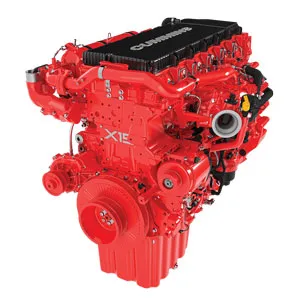
A rendering of Cummins’ EPA- and CARB 2027-compliant HELM X15 diesel engine. (Cummins Inc.)
Forty-eight-volt power means lower amperage in the alternator, maximizing its efficiency as well as reducing the gauge of associated wiring. One heater will precede the diesel oxidation catalyst that sits at the front of the diesel particulate filter, utilizing this catalyst to start the NOx reduction process, and the second will sit at the intake of the SCR catalyst. The two heaters will ensure continual NOx reduction no matter how low engine loads may go. The high-voltage system will operate at maximum efficiency, thus having minimal effect on fuel economy, using simple, lightweight components, according to Ulrich.
In spite of a heavier emission control system, the engine package will be no heavier than the present product because the HELM block is a fresh design. While the same material — gray iron — will provide the material for both the block and head, both Ulrich and Jared Holcomb, on-highway product manager, touted the extensive use of the most advanced design tools for laying out the two structures. Detailed analysis of engine stresses and block design can ensure material is placed only where needed to handle operating stress, they told Transport Topics. This minimizes weight while avoiding any compromise in strength. The optimized design also attenuates noise.
The camshaft drive has been moved to the rear of the block. This eliminates the bolted-on front gear housing used on the present design, and also greatly reduces noise and vibration from the valve system geartrain. This occurs because the rear camshaft drive allows the flywheel’s mass to greatly reduce crankshaft vibration.
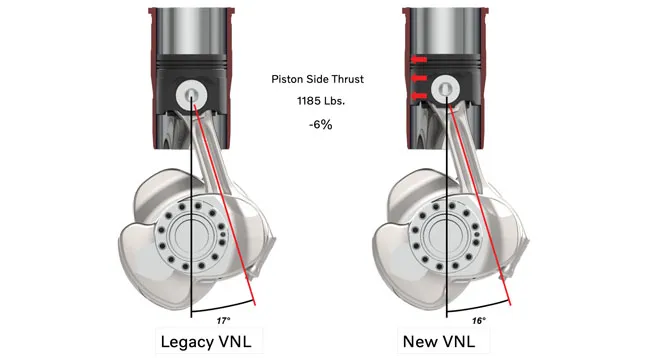
This image shows how the shorter piston (right) allows a longer connecting rod and reduces the angle of the rod from vertical, thus reducing side thrust, on the D13 engine in the 2024 Volvo VNL. (Volvo Trucks)
Another enhancement is dual overhead camshafts — one to drive the intake valves, and the other for the exhausts. This allows a shorter rocker lever between the camshaft and each valve, allowing more rapid valve actions. The result is improved breathing, a significant reduction in engine parasitic loads, lower emissions and better performance and fuel economy. While the new valve-operating system will be simple, provision for variable valve timing has been designed in case such an enhancement will be required in the future. There will be no change in the unusually long 500,000-mile overhead setting requirement.
The performance of the XPI fuel system has been enhanced, the available operating pressure having been increased to 2,400 bar (34,809 psi). Enhancements to piston bowl design and the optimization of the combustion system will further enhance fuel economy.
The new design will be a 2027 product, but the engine families and ratings will remain similar to the present lineup.
The new SCR system is so consistent at providing peak NOx reduction it allows the engine to be tuned for higher fuel efficiency via higher cylinder temperatures and pressures. Even though the package meets the lower 2027 NOx standard, it will do so with only a very small increase in diesel exhaust fluid consumption, meaning a low total cost of operation, according to Ulrich and Holcomb.
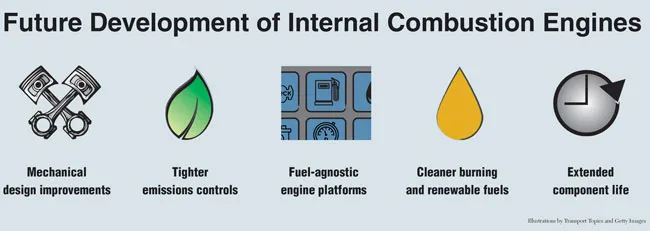
Alternative of the Alternative
At a symposium on future green engines and fuels at the University of Wisconsin two years ago, Andre Boehman, professor of mechanical engineering at the University of Michigan, showed the potential of dimethyl ether as a green fuel for future trucks. Boehman touted DME’s smokeless combustion, high EGR tolerance which allows a significant reduction in engine-out NOx, and its ease of storage and fueling versus natural gas and hydrogen. It also has a high cetane rating, meaning a DME engine would need no spark plugs. Despite that, DME’s disadvantage is its lack of lubricity when compared with diesel fuel. This means present high-pressure-common-rail injection systems would not be durable enough in a DME-fueled diesel engine.
Jeff Loftus of FMCSA joins TT’s Seth Clevenger to discuss the current outlook on ADAS technology and how it will affect the industry at large. Tune in above or by going to RoadSigns.ttnews.com.
Currently, Boehman and Charles Mueller, scientist at Sandia National Laboratories-Livermore, are engaged in a project to overcome the problem while advancing DME combustion. They hope to produce affordable medium- and heavy-duty diesel fuel injection systems that can operate on DME and deliver durability equivalent to that of present diesel injection systems, but Boehman admits that equaling the durability of today’s systems operating on diesel fuel “remains a challenge.” He describes the goal of the project as “developing and demonstrating a DME fuel injection system that ... overcomes the design barriers to a durable and commercializable DME fuel injection system.”
He added in parallel, they are exploring the potential synergy between ducted fuel injection combustion strategies (an innovation from Sandia by Mueller) and DME. Ducted Fuel Injection uses a small duct to enhance the mixing of the fuel sprays with air in the combustion chamber.
Mueller uses an “optical engine,” which allows detailed visual study of combustion at Sandia. He believes that combining ducted fuel injection with DME, which contains some oxygen, may possibly allow low engine-out NOx with much less EGR than present diesels use.
Their present work includes developing advanced injection systems for DME that will also allow the testing of fuel additives that might add to the green fuel’s lubricity. The Department of Energy-funded project will even include a hydraulic valve actuation system that will allow exploration of “high-efficiency engine cycles.” This aspect of the research relies on the fact that varying the timing of valve events in an engine can increase efficiency significantly. They anticipate possible “interesting outcomes” by mid-2025, according to Boehman.
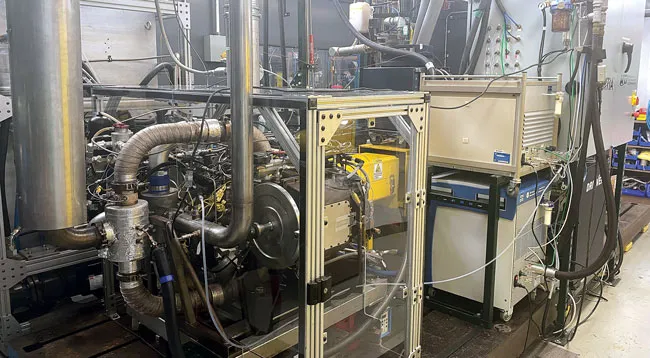
The Achates hydrogen-fueled engine under development in a test cell at the Argonne National Laboratory. Achates is targeting the engine for medium- to large-size commercial trucks. (Argonne National Library)
Laurence Fromm, executive vice president business development at Achates Power, provided information about extensive research at Argonne National Laboratory to adapt the Achates opposed-piston, two-stroke engine to using hydrogen fuel. The research team at Argonne is headed by Essam El-Hannouny, principal mechanical engineer, who said, “For the first time at Argonne, we demonstrated that the opposed-piston engine can run on hydrogen and produce power. We are in the early stages, but the testing provides the data we need to make changes to the combustion mode or other parts of the engine to improve performance.”
Material that Fromm provided explains that the opposed-piston, two-stroke architecture of the Achates engine “eliminates cylinder heads, which are a major cause of heat loss and efficiency in conventional engines.” Fromm also explained that, “At low and mid-loads, the opposed-piston engine can retain a high portion of exhaust gas resulting in temperatures sufficient to enable compression ignition over much or all of the operating range of the engine.” This means this unusual design could end up being the one hydrogen engine on the market that doesn’t need spark plugs, except possibly for cold starts.
Fromm points out that fuel cells are expensive, are sensitive to contaminants, have not yet shown million-mile durability, and also lose efficiency at high loads while internal combustion engines gain efficiency at high loads. Thus, “Applications that require high loads ... like longhaul transportation will likely achieve higher system efficiency with hydrogen combustion than fuel cells.” He advised that Achates is targeting its hydrogen-powered engine for medium- to large-size commercial trucks, among other applications.
All these developments show a real possibility that the internal combustion engine the trucking industry is so accustomed to may survive for many years by adapting in surprising ways to the need to reduce CO2 and other regulated emissions.
Want more news? Listen to today's daily briefing below or go here for more info:





